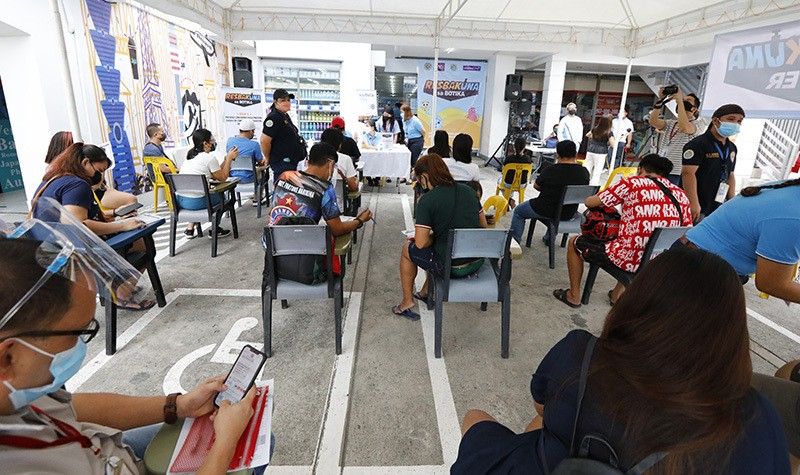OCTA: Metro Manila, Cavite, Rizal now at moderate risk

MANILA, Philippines — Though positivity rates are still high, Metro Manila, Cavite and Rizal are now at moderate risk for COVID-19 infection, independent pandemic monitor OCTA Research said Sunday.
OCTA Research fellow Guido David said in a tweet Sunday morning that Metro Manila could improve to low-risk "within two weeks if [the] downtrend continues."
"Note that positivity rates are still very high at over 20%. Batangas, Laguna, [and] Quezon still at high risk. We need to strictly comply with health protocols to bring this down to low risk," he said.
"Cases are decreasing in Region 4A and 3, and the rest of the Philippines as a whole. The uptick in NCR yesterday was a surprise and not really supported by other indicators. We will see today if the uptick continues."
NCR, Cavite and Rizal at moderate risk based on Covidactnow. Note that positivity rates are still very high at > 20%. Batangas, Laguna Quezon still at high risk. We need to strictly comply with health protocols to bring this down to low risk. @dzbb @allangatus @DZAR1026 @dzrhnews pic.twitter.com/h8tRet9v0t
— Dr. Guido David (@iamguidodavid) January 30, 2022
The moderate classification, David said, was based on indicators used by covidactnow.org. According to CovidActNow, COVID-19 risk in an area is determined based on:
- Daily new cases, which "represents the current amount of COVID in a community."
- Infection rate is the direction and speed of growth. "Daily new cases may be low, but if infection rate is high, then we know that daily new cases will be high in the near future."
- Positive test rate is a measure of our confidence in the underlying data. For instance, if daily new cases and infection rate are both low, but test positivity is high, then the lack of sufficient testing suggests that we are not capturing the true levels of COVID and both daily new cases and infection rate are actually higher than what is currently reported.
As it currently stands, Metro Manila still has an average daily attack rate of 23.01, indicating high risk, along with a low-risk healthcare utilization risk of 40% and a positivity rate of 20%.
The positivity rates of higher than 20%—which mean that more than one in every five tests will come out positive—are still nowhere near the World Health Organization's benchmark of 5% for opening economies.
However, the capital region also registered a growth rate of minus-68%.
Per the Department of Health's data drop, Metro Manila made up 3,625 of the 17,305 cases on Saturday. The new cases were also good for a positivity rate of 33.3% out of 56,447 total tests conducted.
"A low-risk classification will depend on how quickly cases decrease below 1,000 per day. The public must continue to strictly comply with health protocols to sustain the downward momentum," David said.
3625 new cases in the NCR today. This is obviously a surprise increase in cases. Resurgence? It beat the Jan 20 projections for the first time. Hopefully it is just backlog, otherwise, ... I don't want to think yet about the otherwise. pic.twitter.com/Emd3aG8Wcc
— Dr. Guido David (@iamguidodavid) January 29, 2022
— Franco Luna
Bite-sized updates on the emerging coronavirus Omicron variant outbreak and third wave of the pandemic in the Philippines. — Photo by The STAR/Miguel de Guzman
The Philippines logged 599 severe and critical COVID-19 patients in hospitals on June 5, DOH sayd.
Out of the 2,632 ICU beds reserved for COVID-19 patients, only 386 (14.7%) were occupied.
From May 30 to June 5, there have been 1,295 new COVID-19 cases in the country. The daily average is now at 185.
Noong ika-5 ng Hunyo 2022, mayroong 599 na malubha at kritikal na pasyente na naka-admit sa ating mga ospital dahil sa COVID-19. Sa 2,632 ICU beds na nakalaan para sa mga pasyenteng may COVID-19, 386 (14.7%) lamang ang okupado. pic.twitter.com/8cVLPYkZUj
— Department of Health (@DOHgovph) June 6, 2022
The National Capital Region remains the region with most new COVID-19 cases as of March 14, 2022, according to data from OCTA Research.
Metro Manila logged 141 new COVID-19 cases on Monday.
Among provinces, Cebu registered the most new cases with 57, followed by Iloilo with 56, Cavite with 23 and Rizal with 23.
Provinces with the most new cases on 3.14.22. Data was extracted from https://t.co/kM89DgrHW7. Any errors in data should be addressed to DOH. @dzbb @allangatus @News5PH @dzrhnews @DZAR1026 @NewsRmn @dzme_1530khz @dwiz882 @ali_sotto @PhilstarNews @manilabulletin @ManilaTimesNEWS pic.twitter.com/Eda9eTFOSA
— Dr. Guido David (@iamguidodavid) March 15, 2022
Among highly urbanized cities in Luzon, Puerto Princesa is the lone city that remains at moderate risk for COVID-19 due to very high testing positivity rate, OCTA Research says.
As of March 6, NCR, Baguio City, Naga City and Santiago were at low risk.
Meanwhile, Angeles, Dagupan, Lucena and Olongapo improved to very low risk.
HUCs in Luzon as of March 6, 2022. Angeles, Dagupan, Lucena, Olongapo at VERY LOW RISK while NCR, Baguio, Naga City, Santiago at LOW RISK. Puerto Princesa still at MODERATE RISK. @dzbb @DZAR1026 @allangatus @NewsRmn @News5PH @dwiz882 @ali_sotto @PhilstarNews @dzrhnews @EagleNews pic.twitter.com/OVqBboB2a1
— Dr. Guido David (@iamguidodavid) March 7, 2022
The Department of Health logs an additional 941 new COVID-19 cases, bringing the national caseload to 3,666,678.
As of Saturday, there are 49,374 active cases.
The Department of Health reports 853 new COVID-19 cases, bringing the national tally to 3,665,747.
To date, there are 50,230 active cases.
- Latest
- Trending
































